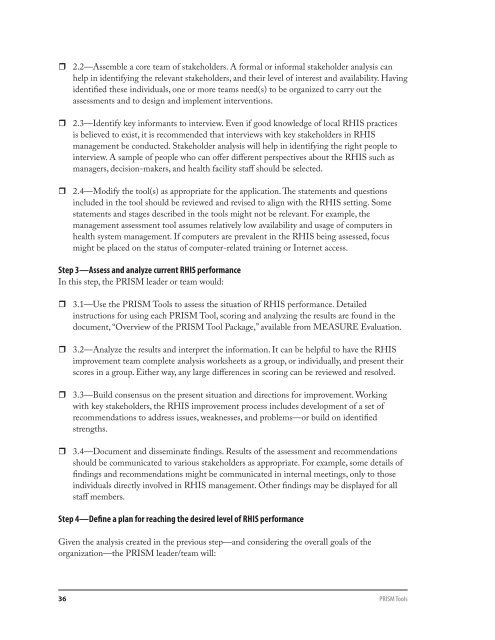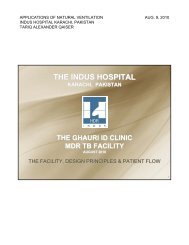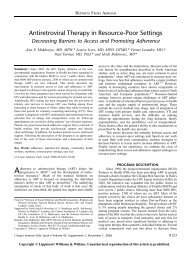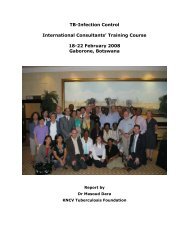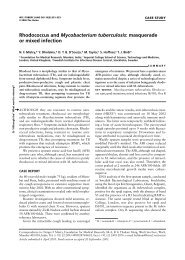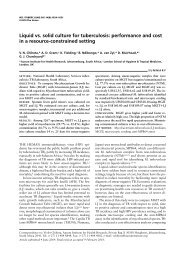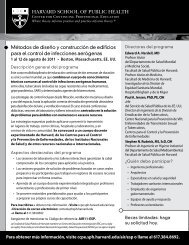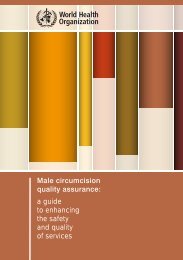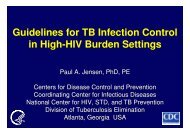PRISM_DescriptionOfTools.pdf - GHDonline
PRISM_DescriptionOfTools.pdf - GHDonline
PRISM_DescriptionOfTools.pdf - GHDonline
You also want an ePaper? Increase the reach of your titles
YUMPU automatically turns print PDFs into web optimized ePapers that Google loves.
2.2—Assemble a core team of stakeholders. A formal or informal stakeholder analysis can<br />
help in identifying the relevant stakeholders, and their level of interest and availability. Having<br />
identified these individuals, one or more teams need(s) to be organized to carry out the<br />
assessments and to design and implement interventions.<br />
<br />
2.3—Identify key informants to interview. Even if good knowledge of local RHIS practices<br />
is believed to exist, it is recommended that interviews with key stakeholders in RHIS<br />
management be conducted. Stakeholder analysis will help in identifying the right people to<br />
interview. A sample of people who can offer different perspectives about the RHIS such as<br />
managers, decision-makers, and health facility staff should be selected.<br />
<br />
2.4—Modify the tool(s) as appropriate for the application. The statements and questions<br />
included in the tool should be reviewed and revised to align with the RHIS setting. Some<br />
statements and stages described in the tools might not be relevant. For example, the<br />
management assessment tool assumes relatively low availability and usage of computers in<br />
health system management. If computers are prevalent in the RHIS being assessed, focus<br />
might be placed on the status of computer-related training or Internet access.<br />
Step 3—Assess and analyze current RHIS performance<br />
In this step, the <strong>PRISM</strong> leader or team would:<br />
<br />
3.1—Use the <strong>PRISM</strong> Tools to assess the situation of RHIS performance. Detailed<br />
instructions for using each <strong>PRISM</strong> Tool, scoring and analyzing the results are found in the<br />
document, “Overview of the <strong>PRISM</strong> Tool Package,” available from MEASURE Evaluation.<br />
<br />
3.2—Analyze the results and interpret the information. It can be helpful to have the RHIS<br />
improvement team complete analysis worksheets as a group, or individually, and present their<br />
scores in a group. Either way, any large differences in scoring can be reviewed and resolved.<br />
<br />
3.3—Build consensus on the present situation and directions for improvement. Working<br />
with key stakeholders, the RHIS improvement process includes development of a set of<br />
recommendations to address issues, weaknesses, and problems—or build on identified<br />
strengths.<br />
<br />
3.4—Document and disseminate findings. Results of the assessment and recommendations<br />
should be communicated to various stakeholders as appropriate. For example, some details of<br />
findings and recommendations might be communicated in internal meetings, only to those<br />
individuals directly involved in RHIS management. Other findings may be displayed for all<br />
staff members.<br />
Step 4—Define a plan for reaching the desired level of RHIS performance<br />
Given the analysis created in the previous step—and considering the overall goals of the<br />
organization—the <strong>PRISM</strong> leader/team will:<br />
36 <strong>PRISM</strong> Tools


